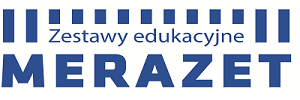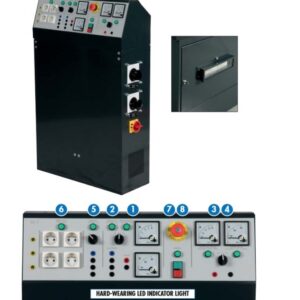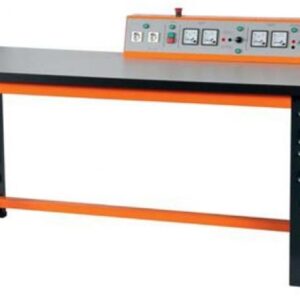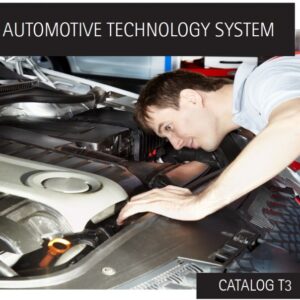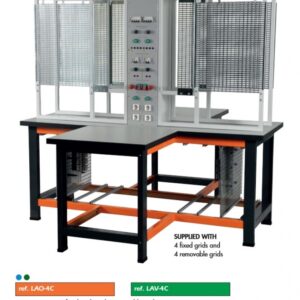Opis
The experiments are carried out using industrial-design machines. All the test machines possess a special base for connecting the Machine test system 1.0. The testing system can be used to record the characteristics of the machines under test. Power for the machines is supplied either via the mains or by special laboratory power supplies.
Objectives
- Protective measures and electrical safety
- Setting up electrical machines and putting them into operation
- Use of starting circuits
- Assessment of electrical machine characteristics
Asynchronous machines with slip-ring rotors have three-phase rotor windings which are accessible. This allows resistors to be switched in during starting. If the rotor is stopped by a control gear, the slip-rotor asynchronous machines can also be used as a three-phase transformer.
Features
- In order to protect against overheating, the stator windings of the machines to be tested are equipped with temperature sensors
- Should overheating occur, the machine test system automatically shuts down the test machine, thus preventing any damage to it.
- The machines to be tested are equipped with an educationally designed terminal board with the winding configuration printed on it.
- The ends of all the windings are connected to the terminal board and can be accessed via 4-mm safety sockets
- Computer-supported acquisition of measurement data provides for meaningful measurement results.
- Machines in the 1 kW rating class have a powerful and realistic operating response
- In comparison to smaller machines, their characteristics display distinctive features related to the design.
The individual equipment set is equally suitable for student experiments in laboratories with low voltage supplies (400 V three-phase) and for setting up on a mobile trolley for demonstration by teachers in a classroom. The procedures for the experiments are provided in a printed manual.
The target group is made up of commercial apprentices and students of electrical machine construction. The course offers experiments at an intermediate level and also allows for the necessary insight into machine behaviour for scientific interpretation at undergraduate level.
When operated with a 400/230 V three-phase, the slip-ring motor needs to be connected in star configuration . If 230/133 V mains power is available, it is possible to use a delta configuration.
Topics
- Connection of a three-phase asynchronous motor
- Reversal of rotation
- Measurement of rotor standstill voltage
- Measurement of rotor current
- Starting using starting resistors
- Changing speed by means of various rotor resistors
- Recording of characteristics with various starting resistors
- Operating a three-phase asynchronous motor as a three-phase transformer
Similar to illustration
| 733 03 | Slip ring motor 1.0 | 1 |
| 732 98 | * Multi-function machine 1.0 | 1 |
| 726 75 | Three-phase supply unit with ELCB | 1 |
| 732 99 | Rotor starter 1.0 | 1 |
| 745 561 | Power circuit breaker module | 1 |
| 732 84 | Motor protection switch, 2.4-4 A | 1 |
| 733 05 | Blocking Gear Mechanism 1.0 | 1 |
| 531 282 | Multimeter Metrahit Pro | 3 |
| 727 12 | Power factor meter | 1 |
| 732 689USB | Machine test system 1.0 | 1 |
| 728 421 | CBM10 MOMO/FCCP | 1 |
| 726 09 | Panel frame T130, two-level | 1 |
| 732 56 | Coupling 1.0 | 1 |
| 732 57 | Shaft end guard 1.0 | 2 |
| 732 581 | Coupling Guard 1.0 transparent | 1 |
| 501 45 | Connecting lead, 19 A, 50 cm, red/blue, pair | 5 |
| 500 59 | Safety bridging plugs, black, set of 10 | 2 |
| 500 591 | Safety bridging plugs, yellow/green, set of 10 | 1 |
| 500 851 | Safety connecting leads, 32 A, set of 32 | 1 |
| 500 852 | Safety connecting leads, 32 A, yellow/green, set of 10 | 1 |
| 566 821L | LIT: Squirrel Cage Motor 380/660V 1.0 (in German) | 1 |
| 566 821S | LIT: Squirrel Cage Motor 380/660V 1.0 (in German) | 1 |
| 566 822 | * LIT: Squirrel Cage Motor 380/660V 1.0 (in English) | 1 |
Articles marked with * are not essential, we do however recommend them to carry out the experiment.
